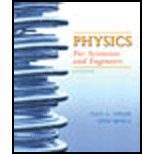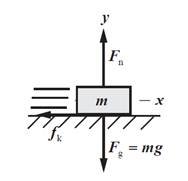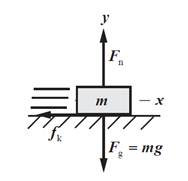
Concept explainers
(a)
To show coefficient of kinetic friction
(a)
Explanation of Solution
Given:
The time measure is
Total displacement of the block is
Formula used:
Draw free body diagram of block.

Write expression for net force in the x -direction.
Substitute
Here,
Rearrange above expression for
Substitute
Here,
Calculation:
Write expression for displacement of the block.
Here,
Substitute
Here,
Substitute
Write expression for the displacement of the block.
Substitute
Substitute
Conclusion:
Thus, the coefficient of kinetic friction is
(b)
The value of coefficient of kinetic friction.
(b)
Explanation of Solution
Given:
The block slides
The time taken is
Formula used:
Draw free body diagram of block.

Write expression for net force in the x -direction.
Substitute
Rearrange above expression for
Substitute
Write expression for displacement of the block.
Substitute
Substitute
Write expression for the displacement of the block.
Substitute
Substitute
Calculation:
Substitute
Conclusion:
Thus, the value of the kinetic friction is
(c)
The initial speed of the block
(c)
Explanation of Solution
Given:
Formula used:
Draw free body diagram of block.

Write expression for net force in the x -direction.
Substitute
Rearrange above expression for
Substitute
Write expression for displacement of the block.
Substitute
Substitute
Calculation:
Substitute
Conclusion:
Thus, the initial speed of the block is
Want to see more full solutions like this?
Chapter 5 Solutions
Physics for Scientists and Engineers, Vol. 1
- A 1.57 kg mass is sliding across a horizontal surface an initial velocity of 12.9 m/s i. If the object then comes to a stop over a time of 4.23 seconds, what must the coefficient of kinetic be? Assume that only friction, the normal force, and the force due to gravity are acting on the mass. Enter a number rounded to 3 decimal places.arrow_forwardA 110 g hockey puck sent sliding over ice is stopped in 15 m by the frictional force on it from the ice. (a) If its initial speed is 6.0 m/s, what is the magnitude of the frictional force? (b) What is the coefficient of friction between the puck and the ice?arrow_forwarda block of mass m is initially traveling upward along a ramp at speed v. The coefficient of kinetic friction between the block and the ramp is Mk. (a) Using Newton's second law, solve for the normal force on the block due to the ramp. (b) Using Newton's second law solve for the acceleration of the block.arrow_forward
- A 75−kg box is pulled over a rough surface using a horizontal force of 100N at a constant velocity. Find the coefficient of friction between the box and the surface?arrow_forwarda 400 N block slides on a horizontal plane by applying a horizontal force of 200 N and reaches a velocity of 20 m/s in a distance of 30 m. from rest. compute the coefficient of friction between the floor and the block.arrow_forwardThe washer launched on the ice surface with a speed of v = 30 m / s stopped after a time t = 50 s. Determine the force of resistance to movement and the coefficient of friction μ, if the mass of the washer m = 500 g.arrow_forward
- Police examine the scene of an accident involving two cars, which is parked. The skid marks of the moving car, which nearly came to a stop before the collision, is 80 meters long. The coefficient of kinetic friction between rubber and the pavement is about 0.80. Estimate the initial speed of the car.arrow_forwardA skater with an initial speed of 6.80 m/s stops propelling himself and begins to coast across the ice, eventually coming to rest. Air resistance is negligible. (a) The coefficient of kinetic friction between the ice and the skate blades is 0.0700. Find the deceleration caused by kinetic friction. (b) How far will the skater travel before coming to rest?arrow_forwardFigure 1 В А Three blocks, labeled A, B, and C, are connected by essentially massless strings that run over essentially massless and frictionless pulleys (as shown in Figure A above). Block A hangs straight down. The string from block A connects to block B which is sliding up and to the left along an inclined plane. The plane is inclined at an angle of theta = 0 = 52 degrees away from vertical. The coefficient of kinetic friction between block B and the plane is 0.38. Block B is connected by a different string to block C which hangs straight down. Block A has a mass of 4.1 kg. Block B has a mass of 3.7 kg. Block C has a mass of 2.5 kg. Block A is moving down and block C is moving up (the strings do not stretch). The only significant forces acting on the blocks are friction acting on block B, normal forces, tension forces, and gravity (with g = 9.81 m/s²). Calculate the %3D acceleration (in units of meters per second squared) of block A. For block A, a downward acceleration is…arrow_forward
- A motorcyclist is coasting with the engine off at a steady speed of 20.0 m/s but enters a sandy stretch where the coefficient of kinetic friction is 0.70. Will the cyclist emerge from the sandy stretch without having to start the engine ifthe sand lasts for 15 m? If so, what will be the speed upon emerging?arrow_forwardna place where gravitational acceleration has 10 m / s2 module, the set below, in which friction is negligible, he pulley and the wire are ideal. Under these conditions, what is the strength of the force that the block is exercised in Block B? Given: a = 37° m (A) = 6,0 kg m (B) = 4,0 kg %3D m (C) = 10 kgarrow_forwardA skier weighing 90 kg starts from rest down a hill inclined at 17. He skis 100 m down the hill and then coasts for 70 m along level snow until he stops. Find the coef ficient of kinetic friction between the skis and the snow. What velocity does the skien have at the bottom of the hill?arrow_forward
 Classical Dynamics of Particles and SystemsPhysicsISBN:9780534408961Author:Stephen T. Thornton, Jerry B. MarionPublisher:Cengage Learning
Classical Dynamics of Particles and SystemsPhysicsISBN:9780534408961Author:Stephen T. Thornton, Jerry B. MarionPublisher:Cengage Learning
